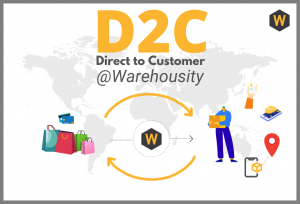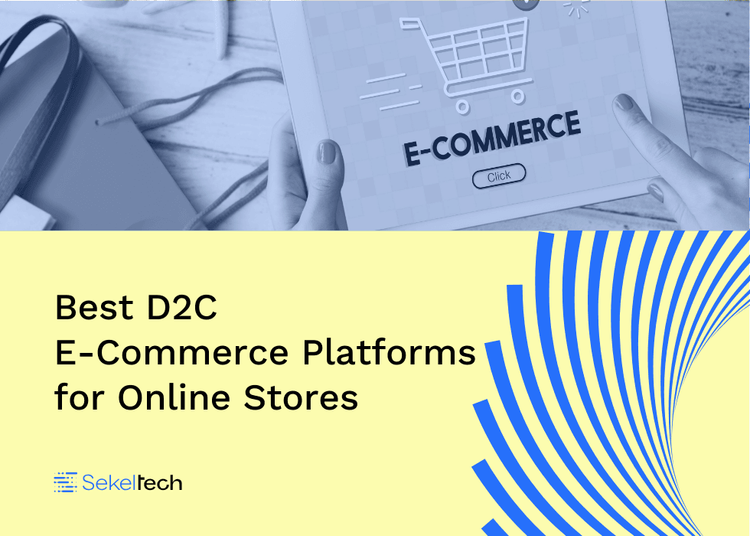Discovering the Prospective of D2C Ecommerce: A Comprehensive Overview for Companies
The D2C ecommerce design presents a significant shift in just how brands engage with customers. It enables firms to bypass traditional retail channels, promoting deeper connections and potentially enhanced profit margins. This method is not without its complexities. Recognizing the nuances of D2C ecommerce is essential for brands intending to prosper. What techniques can they embrace to navigate this developing landscape efficiently? The responses might redefine their service strategies.
Comprehending the D2C Ecommerce Design

Secret Advantages of D2C Ecommerce for Brands
The D2C ecommerce design provides brand names significant advantages, especially concerning increased profit margins. By getting rid of intermediaries, firms can retain a larger share of sales revenue. Furthermore, this straight connection with consumers promotes enhanced brand loyalty, motivating repeat acquisitions and long-term interaction.
Enhanced Revenue Margins

Boosted Brand Loyalty
Structure on the economic benefits of D2C ecommerce, improved brand commitment becomes one more important advantage for business engaging straight with customers. By developing a straight connection, brands can promote deeper partnerships with their customers, acquiring insights into behaviors and preferences. This direct interaction permits more personalized marketing techniques, which resonate strongly with consumers. In addition, brand names have the possibility to manage their messaging and client experience, reinforcing brand worths and constructing count on. When consumers feel an individual connection, they are a lot more most likely to return, support for the brand, and join neighborhood involvement. Inevitably, boosted brand name loyalty not just drives repeat acquisitions but also cultivates an enthusiastic consumer base, additional strengthening a brand's setting out there.
Difficulties Faced by D2C Brands
D2C brand names come across numerous considerable obstacles that can influence their success. Inventory administration issues can cause stock shortages or excess, complicating operations and client satisfaction. Furthermore, marketing budget constraints frequently limit the ability to properly involve and get to target market.
Inventory Administration Issues
Effective supply administration provides a formidable difficulty for numerous brand names operating in the direct-to-consumer (D2C) space. These brands commonly grapple with varying need, which can result in overstock or stockouts, ultimately impacting customer complete satisfaction and profits. In addition, the lack of innovative stock radar can cause disparities in between real stock levels and reported data, complicating order satisfaction. The varied variety of products D2C brand names normally provide also makes complex stock monitoring, as variants in dimensions, designs, and shades need even more meticulous oversight. Additionally, several D2C businesses might fight with restricted warehousing abilities, causing inefficient usage of space and resources. Subsequently, reliable inventory monitoring remains a crucial obstacle for D2C brands aiming for sustainable growth and operational efficiency.
Advertising Spending Plan Constraints
Maneuvering advertising budget plan constraints is a considerable difficulty for numerous direct-to-consumer (D2C) brands. Limited economic sources often limit these companies' capacity to invest in all-encompassing advertising techniques, leading to reduced presence in a competitive market. D2C brands often face the requirement to maximize return on investment (ROI) while targeting details target markets efficiently. This obstacle is exacerbated by increasing prices in digital advertising and the need to assign funds across several networks, consisting of social networks, online search engine, and e-mail marketing. Numerous D2C brands have to innovate cost-efficient marketing options, leveraging natural development techniques and influencer collaborations. Eventually, successfully steering these budget restrictions is crucial for sustaining growth and accomplishing long-lasting earnings in the developing ecommerce landscape.
Methods for Developing a Successful D2C Ecommerce Service
As customers significantly look for straight links with brand names, developing an effective D2C ecommerce service needs a tactical technique that focuses on client engagement and depend on. One reliable method is to produce compelling brand narratives that resonate with target audiences, promoting psychological connections. Using social media sites systems can boost presence and help with two-way interaction, enabling brands to involve straight with customers.Moreover, customized experiences via customized advertising efforts can substantially boost consumer retention and commitment. Applying commitment programs and offering unique offers can even more incentivize repeat purchases.Streamlining the purchasing process is important, ensuring a straightforward user interface that improves the shopping experience. In addition, clear interaction pertaining to shipping and returns develops count on and urges consumer confidence.Finally, proactively looking for consumer responses and reacting to it demonstrates a commitment to enhancement and customer contentment, important aspects in the competitive D2C landscape.
Leveraging Modern Technology for Boosted Customer Experience
In today's competitive D2C ecommerce landscape, innovation plays an essential role fit consumer experiences. Companies progressively make use of innovative devices such as expert system, chatbots, and individualized formulas to boost communications and enhance the buying process. By integrating these technologies, brands can give customized item referrals based on individual preferences and purchasing actions, fostering a more appealing experience.Moreover, responsive web site styles and mobile applications guarantee that clients can access services perfectly throughout different devices. Boosted payment options, including one-click checkouts and electronic purses, additionally simplify transactions, making it easier for consumers to make purchases.Data analytics also enables businesses to gather insights right into consumer behavior, enabling for continual renovation of services and offerings. On the whole, leveraging modern technology not only improves client satisfaction but additionally cultivates loyalty, D2C Ecommerce Agency eventually driving long-lasting success in the D2C ecommerce market.
Advertising Tips to Drive D2C Sales
Exactly how can brand names effectively capture the attention of consumers in a saturated market? To grow in the direct-to-consumer (D2C) landscape, brand names need to employ targeted advertising strategies. Utilizing social media sites systems, brand names can engage customers with interactive material, influencer partnerships, and user-generated articles. Customized email projects can additionally cultivate a feeling of link, offering customized promos based upon consumer behavior and preferences.Moreover, narration plays a crucial duty in differentiating a brand name's narrative, making it relatable and unforgettable. Brands must purchase seo (SEO) to enhance presence, ensuring their items are easily visible online. Furthermore, leveraging data analytics enables businesses to refine their advertising methods and comprehend customer trends much better. Inevitably, a multi-channel strategy that combines creative thinking with data-driven understandings can greatly enhance D2C sales, enabling brands to stand apart in a jampacked market.
Future Fads in D2C Ecommerce
With the fast advancement of modern technology and customer preferences, the future of D2C ecommerce is poised for substantial transformation. Emerging patterns show a change in the direction of hyper-personalization, where brands leverage data analytics to tailor offerings to individual customer demands. This customization enhances customer experiences, fostering commitment and engagement.Moreover, sustainability is ending up being a vital aspect, with customers significantly favoring brands that focus on environment-friendly methods - D2C Ecommerce Agency. Business are expected to embrace transparent supply chains and sustainable products to meet this demand.The assimilation of expert system and increased truth will additionally change the buying experience, allowing customers to imagine products in their environments before acquisition. On top of that, social commerce is prepared for to grow, as systems like Instagram and TikTok assist in smooth purchasing experiences directly within social media.These patterns jointly indicate a dynamic future for D2C ecommerce, stressing customer-centric strategies and ingenious modern technologies that redefine customer communications
Frequently Asked Questions
What Industries Benefit Most From D2C Ecommerce?
The present inquiry highlights markets that thrive with direct-to-consumer (D2C) ecommerce. Extremely, fashion, beauty, electronics, and food markets leverage D2C versions to enhance brand name commitment, improve customer connections, and maximize earnings margins efficiently.
Just How Do Delivering Expenses Influence D2C Pricing Approaches?
Delivering expenses substantially affect D2C rates strategies. Services have to stabilize these costs with competitive pricing, taking into consideration customer expectations and profit margins. Efficient management of delivery can improve customer satisfaction and drive sales in direct-to-consumer models.
What Settlement Alternatives Should D2C Businesses Offer?
D2C services must use varied repayment alternatives, including credit/debit cards, digital purses, and purchase currently, pay later solutions. This selection enhances consumer benefit, increases conversion prices, and deals with various customer choices in the online purchasing landscape.
Just How Can D2C Brands Manage Client Returns Effectively?
D2C brand names can deal with consumer returns efficiently by applying easy to use return plans, supplying prepaid shipping tags, and making certain prompt refunds (D2C Ecommerce Agency). Clear interaction and structured procedures boost client satisfaction and urge repeat business
What Legal Considerations Exist for D2C Ecommerce Procedures?
Lawful factors to consider for D2C ecommerce operations consist of compliance with consumer protection laws, information privacy guidelines, intellectual building rights, and tax demands. Brands should navigate these intricacies to stay clear of legal pitfalls and ensure smooth operations. By removing intermediaries, D2C brand names can offer affordable pricing and cultivate an extra intimate connection with their customers.The D2C model is identified by its dependence on electronic systems, enabling brands to utilize social media, online markets, and their own sites to involve with customers directly. D2C ecommerce promotes the collection of beneficial client information, making it possible for brands to customize their offerings and advertising and marketing approaches effectively, ultimately driving sales and boosting margins. Additionally, brands have the opportunity to control their messaging and client experience, enhancing brand name worths and building trust fund. As consumers increasingly seek direct connections with brand names, developing an effective D2C ecommerce company needs a tactical approach that prioritizes consumer interaction and trust fund. D2C brand names can deal with customer returns efficiently by applying easy to use return policies, using pre paid delivery labels, and guaranteeing timely refunds.